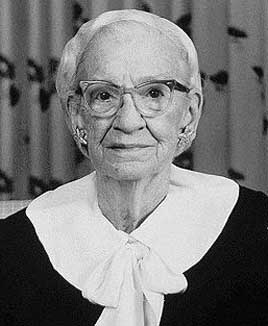Grace Hooper

Grace Hopper was born in New York
City on December 9, 1906; She was the oldest of three children. At the
age seven, Grace was fidgeting with gadgets, disassembling seven alarm
clocks in the attempt to determine how they worked. She shared her love
of math with her mother, who studied geometry by special arrangement when
serious study of math was still thought improper for a woman. Her father
was a successful insurance that had both of his legs amputated encouraged
Grace that she could do anything if she put her mind to it. He inspired
Hopper to pursue higher education and to avoid being limited to typical
feminine roles.
At the age of 16, Hopper applied
to Vassar College. Because she failed her Latin exam, The college told
her she must wait a year. She graduated from Vassar in 1928, with a Bachelor's
Degree in Mathematics and Physics. In 1930, at age 23, she received her
Master's Degree in Mathematics from Yale University. She then married Vincent
Foster Hopper in the same year. He was an English instructor at New York
School of Commerce. The following year Vassar hired her as a mathematics
instructor. Hopper taught at Vassar until 1943. In 1936 she published a
paper on "The ungenerated seven as an index to Pythagorean number theory"
in the American Mathematical Monthly.
At the age of 16, Hopper applied
to Vassar College. Because she failed her Latin exam, The college told
her she must wait a year. She graduated from Vassar in 1928, with a Bachelor's
Degree in Mathematics and Physics. In 1930, at age 23, she received her
Master's Degree in Mathematics from Yale University. She then married Vincent
Foster Hopper in the same year. He was an English instructor at New York
School of Commerce. The following year Vassar hired her as a mathematics
instructor. Hopper taught at Vassar until 1943. In 1936 she published a
paper on "The ungenerated seven as an index to Pythagorean number theory"
in the American Mathematical Monthly.
During World War 2 Grace decided
to join the Navy however, at the age of 34, weighing 105 pounds, she was
considered overage and underweight for military enlistment. Navy officials
asked her to remain a civilian. This did not stop Grace Hopper. She obtained
a waiver for the weight requirement (special government permission) and
a leave of absence from Vassar College. In 1943, she was sworn into the
U.S. Naval Reserve. In the Navy she became the third programmer of the
Mark I, the world's first large-scale automatically sequenced digital computer.
The computer was used to calculate aiming angles for Naval guns in varying
weather conditions. In 1946 Grace received the Naval Ordnance Development
Award for her work on the Mark series.
In 1946 Grace Hopper resigned
from the Navy. In 1949 She joined the Eckert-Mauchley Computer Corporation
as a senior mathematician. There she helped develop standard languages
for the modern computer. Rear Admiral Grace Hopper died January 1,
1992. She was buried with full military honors at Arlington National Cemetery.
Charles
Babbage | Pascal |
Howard Aiken

